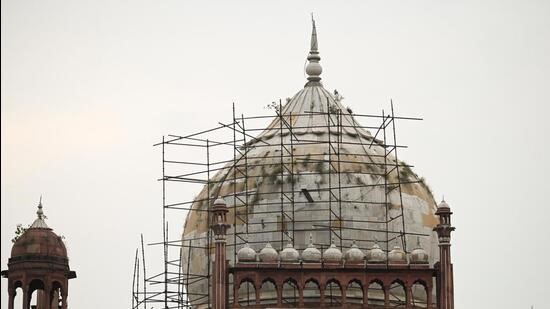Description

Disclaimer: Copyright infringement not intended.
Context
- The Archaeological Survey of India (ASI) is set to finish conservation and restoration work on the central dome of Safdarjung Tomb by the end of the month.
Details
Introduction
- Safdarjung Tomb, located in New Delhi, India, is a splendid mausoleum constructed in the 18th century.
- It serves as the final resting place of Safdarjung, a prominent statesman and Nawab of Oudh, who was also the Prime Minister of the Mughal Empire under Muhammad Shah.
- The tomb stands as a fine example of Mughal architecture and is a significant historical monument in the capital city.
Historical Background
- Safdarjung, whose real name was Mirza Muqim Abul-Mansur Khan, was born in 1708 and served in various high-ranking positions during the Mughal Empire.
- After his death in 1754, his son Nawab Shujaud Daula decided to build a grand mausoleum in his honor, which came to be known as the Safdarjung Tomb.
- Construction of the tomb began in 1753 and was completed in 1754.
- Mirza Muqim Abulmansur Khan, also known as Safdarjung, was appointed the viceroy of Awadh by Emperor Muhammad Shah.
- Later, Emperor Ahmed Shah appointed him to the position of Wazir (prime minister).
- Safdarjung died in September 1754 in Faizabad and was eventually buried inside the tomb that carries his name.
- The tomb was built for around three lakh rupees (18th-century rupee), according to Maulvi Zafar Hasan, an assistant superintendent of ASI who prepared the first list of monuments worthy of conservation in 1916.

Architectural Marvel
- The tomb exhibits a fusion of Mughal and Persian architectural styles, inspired by the grandeur of Humayun's Tomb and Taj Mahal.
- The structure is built with red and buff sandstone, giving it an imposing appearance.
- It features a large central dome surrounded by four smaller domes, creating an elegant and harmonious architectural composition.
- The intricate marble inlay work and decorative carvings on the walls and ceilings showcase the artistic brilliance of Mughal craftsmanship.
Garden and Layout
- The tomb is situated in the center of a sprawling charbagh (four-part) garden, a classic feature of Mughal garden design.
- The garden is divided into four quadrants, each with pathways leading to the central tomb, representing paradise as per Islamic beliefs.
- Chahar Bagh style of garden layout symbolizes the four rivers of paradise mentioned in the Quran.
The Main Tomb Chamber
- The central tomb chamber houses the cenotaph of Safdarjung. The actual burial site lies in the basement.
- The walls of the chamber are adorned with delicate ornamentation and intricate calligraphy, showcasing Persian and Arabic verses.
Mausoleum's Pavilion
- The tomb is flanked by pavilions on its north and south sides, which serve as ornamental gateways.
- These pavilions are known for their beautifully arched entrances and intricate detailing.
Impact and Legacy
- The Safdarjung Tomb stands as a testament to the architectural brilliance of the Mughal era and serves as an important historical landmark in Delhi.
- It has influenced subsequent Mughal and Indo-Islamic architectural styles, inspiring other structures built during the later periods.
- Today, the tomb and its garden complex are well-preserved heritage sites, attracting visitors and history enthusiasts from all over the world.
Conclusion
The Safdarjung Tomb is not only a remarkable architectural marvel but also a tribute to the legacy of a significant figure in Mughal history. The fusion of Mughal and Persian styles, the well-maintained gardens, and the intricate detailing make it a must-visit destination for those interested in India's rich cultural heritage and architectural splendor.
|
PRACTICE QUESTION
Q. Which of the following statements about the Safdarjung Tomb is/are correct?
1. Safdarjung Tomb was constructed in the 17th century during the reign of Emperor Shah Jahan.
2. The tomb is located in New Delhi and serves as the final resting place of Safdarjung, the Prime Minister of the Mughal Empire.
3. The architectural style of the tomb is predominantly influenced by Persian and European designs.
4. The tomb is surrounded by a char bagh-style garden, representing paradise as per Islamic beliefs.
A) Only Statement 1 and Statement 2 are correct.
B) Only Statement 2 and Statement 3 are correct.
C) Only Statement 2 and Statement 4 are correct.
D) Only Statement 3 and Statement 4 are correct.
Answer: C
|
.jpg)
https://www.hindustantimes.com/cities/delhi-news/asi-to-restore-safdarjung-tomb-dome-in-delhi-by-julyend-101690135802905.html







